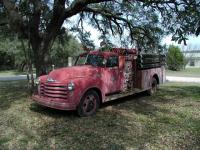-small.jpg)
The Bird and Butterfly Trail west of the Trailhead is the easiest and provides the most shade.
From Burnet, head west on Hwy 29. Turn right and head towards the northwest on FM 2341. Continue on 2341 for several miles until it dead-ends at the park entrance. After entering the park turn left behind the entrance station building and park at the trailhead on the right. Be sure to get your day pass at the main Lodge first.
The Hike: The trails at Canyon of the Eagles are a complex of loops that allow for creating a hike of almost any length requiring any level of effort you desire. Upon entering the park be sure to follow the signs to the west towards the main lodge where you can pay the park's entrance fee and pick up a trail map.
The trail maps at Canyon of the Eagles are just about the best trail maps that you'll find
anywhere. Printed on sturdy stock, they include contour lines more precise than you'll find on most USGS maps. All trail intersections are numbered and the actual trail markers in the field bear the same numbers making it easy to figure out exactly where you are and how to get where you want to go.

I'm not sure how an old, rural fire truck from Morrill, Nebraska ended up near the trailhead.
I actually started my hike at the alternate trailhead just north of the "Trailhead" waypoint where I parked my car. This is just a short hop away and the trail here starts near the bulletin board for the Eagle Eye Observatory. The parks calls this the Faris Lookout Trail and it heads north towards a hilltop just on the northern boundary of the park.
-small.jpg)
The trail leading to Faris Lookout was lush with green grasses, early enough in the year to not be a nuisance.
On a mild winter day it almost felt like spring was coming on. Moisture was in the air, clouds were moving in later in the day and the grass along the trail was a vibrant green. It was like walking on carpet in some spots. Later in the spring and summer this same grass may be more of an annoyance when it starts to get to knee-height.
When the trail nears the waypoint "View" keep an eye out on the left for the continuation of the trail. Once you get to the actual view you'll need to double back a short distance to it. Don't try to follow the fence line westward here. That's not the official trail.
-small.jpg)
Lake Buchanan as seen from Faris Lookout.
Unlike the Juniper Ridge trails, the elevation gains and descents here are mild with much of the elevation gain spread out over a larger area. The trails leading up to and down from the "View" waypoint are just about the steepest on this side of the park. One could easily follow the trails that line the lake and avoid the elevation gain altogether, but you'll just be missing out on the most remote portions of the trails that provide the best views. In general, the eastern half of the trail system is hilly and the western half flat.
-small.jpg)
There's not much shade along most of the trail. A scattering of oaks, a few Junipers and lots of shrub.
Heading west from the view I looped around every trail that I could find, first filling up the hillier eastern trails, shuffling between waypoints "13" through "18". Arguably there is a better view of the lake on the Vireo Hill Trail between waypoints "15" and "16". Though not as high up and with somewhat less lake showing, the view is not hampered a high fence in the field of view.
-small.jpg)
The trail cuts through the shrubs with Lake Buchanan in the distance.
Compared to much of the hillcountry, there was a surprising lack of Juniper in many places along the Lakeside trails. Historically Juniper was not as prevalent as today and in order to provide the variety of habitat found in the past the Juniper may have been cut back by the park staff. The thickets of brush that would have perished under a canopy of Juniper seemed to attract a large number of birds including Cardinals, Robins, Mockingbirds and Sparrows. Although Golden Cheeked Warblers need Juniper for their nest building materials, the Black Capped Vireos actually prefer Shin Oak and other shrubs and nests about 2-4 feet off the ground. So the cover here may be more to their liking.
-small.jpg)
Looking down on the trails near Tanner Point. The structure on the left is a deer blind.
I finished off my 9 miles of hiking by completing the trails along the lake shore. There are more people in this area, particularly near the waypoint "Tanner Point" given its close proximity to the park's camping areas. Although at the height of Bald Eagle season, I failed to spot any along the lake, much to my disappointment.
Two sections of the trail are closed at certain times of the year for endangered and threatened species protected. The eastern half of the Lakeside trail system is closed from March 1 through August 31 for the Golden-Cheeked Warbler and the Black-Capped Vireo. I think this half of the trail is the best half, so you may want to plan your visit for fall or winter. Another much smaller section of the trail along the lake is closed from November 1 - March 15 for the Bald Eagles.